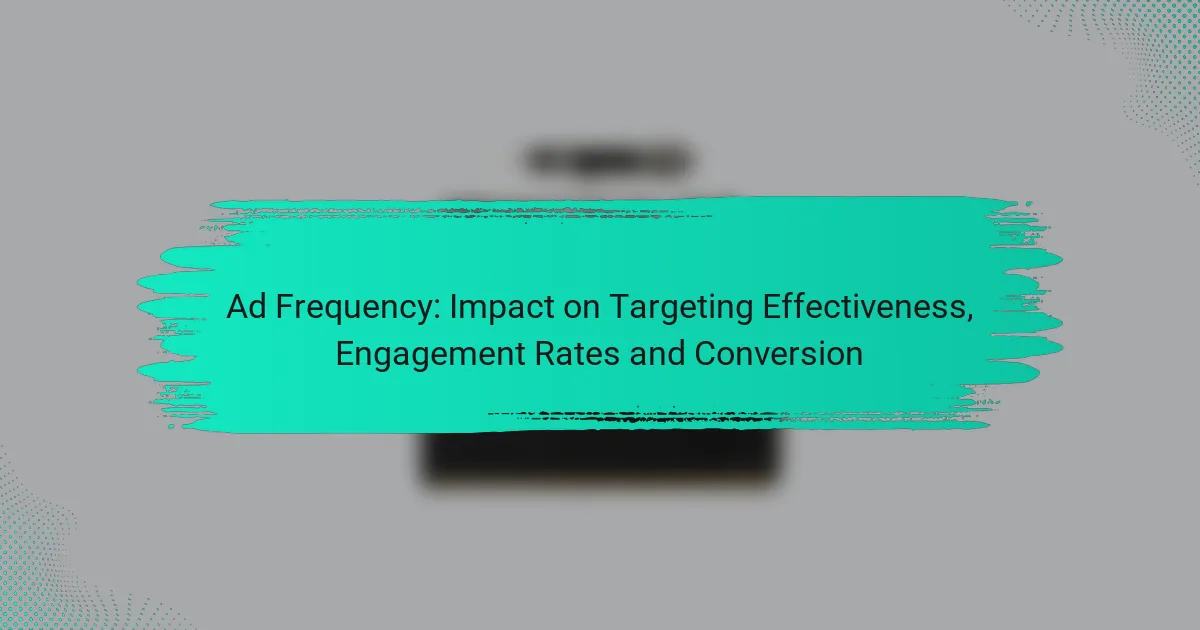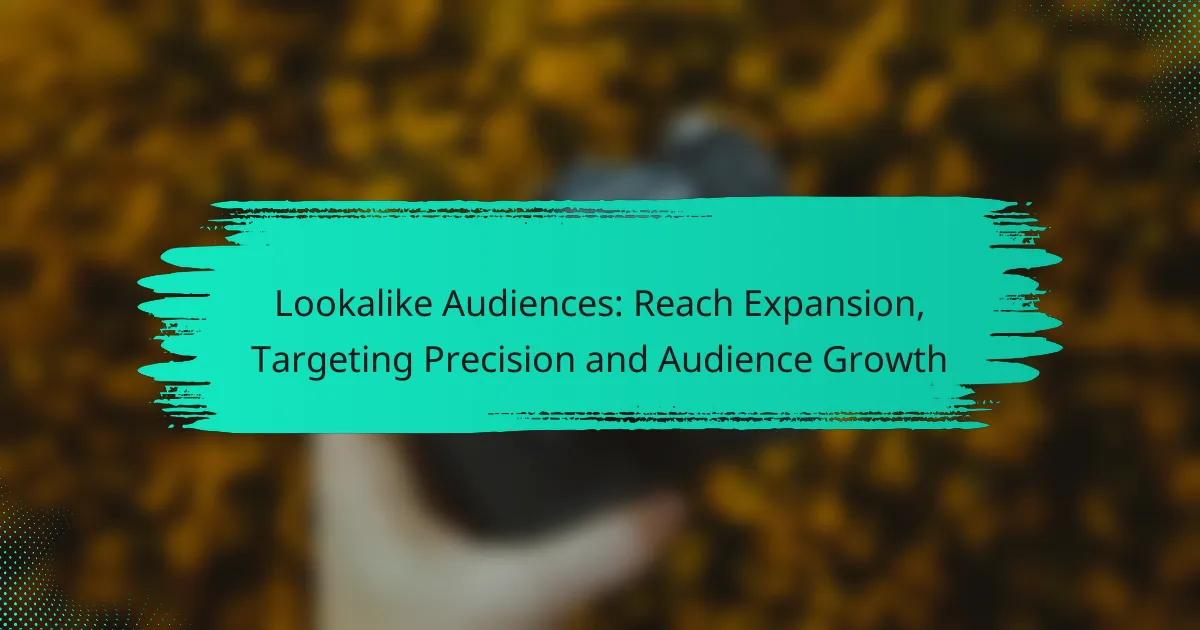Ad frequency plays a crucial role in shaping the effectiveness of targeting in display advertising, as it dictates how often potential customers encounter an ad. While increased frequency can enhance brand recall and engagement, too much exposure may lead to ad fatigue, ultimately diminishing effectiveness. Finding the right balance in ad frequency is essential for maximizing engagement rates and improving conversion outcomes.
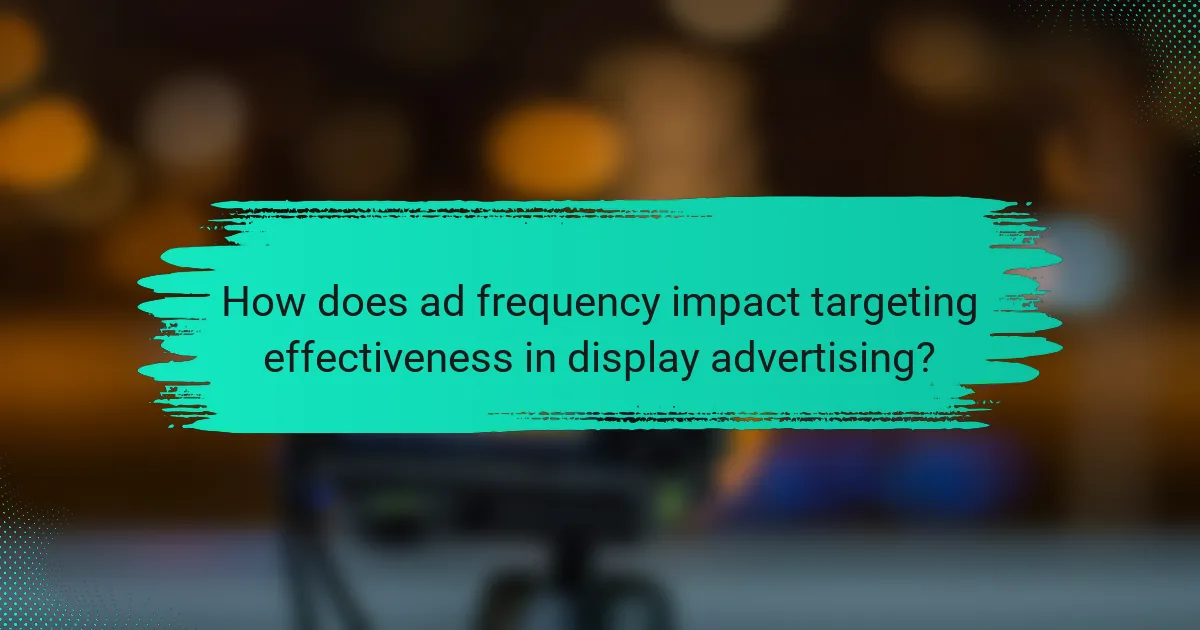
How does ad frequency impact targeting effectiveness in display advertising?
Ad frequency significantly influences targeting effectiveness in display advertising by determining how often a potential customer sees an ad. Higher frequency can lead to improved brand recall and engagement, but excessive exposure may result in ad fatigue, reducing overall effectiveness.
Increased frequency enhances audience recall
When ads are shown more frequently, they are more likely to stick in the minds of viewers. This repeated exposure reinforces brand recognition and helps potential customers remember the product or service when making purchasing decisions. Studies suggest that a frequency of three to five impressions can effectively boost recall without overwhelming the audience.
However, it’s essential to balance frequency with quality. If the same ad is shown too many times, it can lead to diminishing returns as viewers may start to ignore the ad or develop negative feelings towards the brand. Regularly refreshing ad creatives can help maintain interest and effectiveness.
Optimal frequency improves ad relevance
Finding the optimal ad frequency is crucial for maintaining ad relevance. When ads are shown too infrequently, they may not make a significant impact, while too much exposure can lead to annoyance. Aiming for a frequency of around four to six impressions per week is often recommended for maximizing relevance without causing fatigue.
Additionally, utilizing data analytics to monitor engagement rates can help advertisers adjust frequency in real-time. By analyzing metrics such as click-through rates and conversion rates, advertisers can fine-tune their strategies to ensure that their ads remain relevant and effective for their target audience.
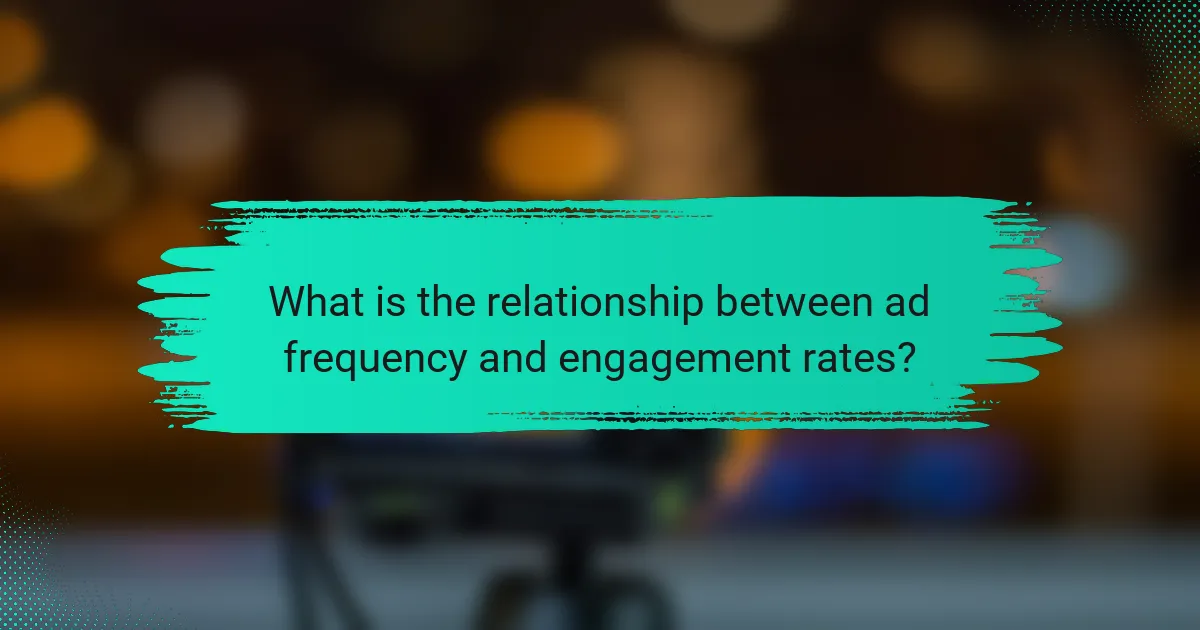
What is the relationship between ad frequency and engagement rates?
The relationship between ad frequency and engagement rates is complex; higher frequency can diminish user interest, while moderate frequency can enhance interaction. Striking the right balance is crucial for maximizing effectiveness and achieving desired outcomes.
Higher frequency can lead to ad fatigue
When ads are shown too frequently, users may experience ad fatigue, leading to decreased engagement. This fatigue can manifest as a decline in click-through rates and overall interest in the product or service being advertised.
To avoid ad fatigue, consider limiting the frequency to a range of 3-5 impressions per user per week. Monitoring engagement metrics can help identify when fatigue sets in, allowing for timely adjustments to the campaign.
Moderate frequency boosts interaction rates
Moderate ad frequency, typically around 2-4 impressions per user per week, can effectively enhance interaction rates. This level of exposure keeps the brand top-of-mind without overwhelming the audience.
Utilizing A/B testing can help determine the optimal frequency for your specific audience. Adjusting ad frequency based on user response can lead to improved engagement and higher conversion rates, making it a vital strategy in digital marketing.
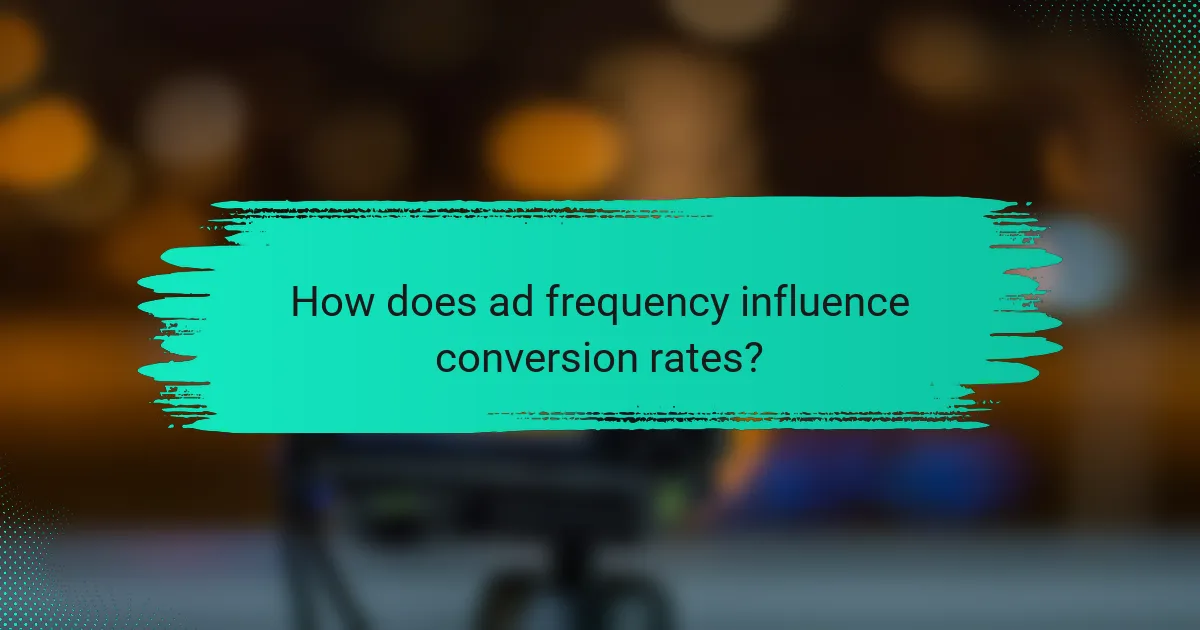
How does ad frequency influence conversion rates?
Ad frequency significantly impacts conversion rates by determining how often potential customers see an advertisement. Higher frequency can lead to ad fatigue, while optimal frequency can enhance brand recall and encourage action.
Excessive frequency may decrease conversions
When ads are shown too frequently, they can overwhelm or annoy potential customers, leading to a negative perception of the brand. This phenomenon, known as ad fatigue, can result in lower engagement rates and diminished conversion effectiveness.
For example, if a user sees the same ad multiple times in a single day, they may start to ignore it or develop a negative association with the brand. It’s generally advisable to limit ad exposure to a few impressions per week to maintain interest without causing irritation.
Balanced frequency maximizes conversion potential
Maintaining a balanced ad frequency helps ensure that potential customers are reminded of the product without feeling bombarded. Research suggests that showing ads around three to five times per week can effectively enhance recall and encourage conversions.
To achieve this balance, marketers should monitor engagement metrics and adjust frequency based on audience response. Utilizing A/B testing can help determine the optimal frequency for different segments, ensuring that ads remain effective without causing fatigue.

What are the best practices for managing ad frequency?
Managing ad frequency effectively involves balancing exposure to maximize engagement without causing ad fatigue. Key practices include implementing frequency capping and analyzing audience behavior to determine optimal settings.
Utilize frequency capping techniques
Frequency capping limits the number of times an individual sees the same ad within a specified timeframe. This approach helps prevent user annoyance and potential negative brand perception. A common practice is to set caps at 2-4 impressions per user per day, depending on the campaign goals.
Implementing frequency capping can be done through most advertising platforms, allowing advertisers to adjust settings based on performance metrics. Regularly review these settings to ensure they align with audience engagement levels and conversion rates.
Analyze audience behavior for optimal settings
Understanding audience behavior is crucial for determining the right ad frequency. Analyze metrics such as click-through rates (CTR), conversion rates, and engagement levels to identify how often your target audience interacts with your ads. This data can guide adjustments to frequency settings for better results.
Consider segmenting your audience based on their interaction history. For example, users who frequently engage with your content may benefit from higher frequency, while those who show less interest might require lower exposure to avoid fatigue. Regularly testing and refining these settings can lead to improved campaign performance.
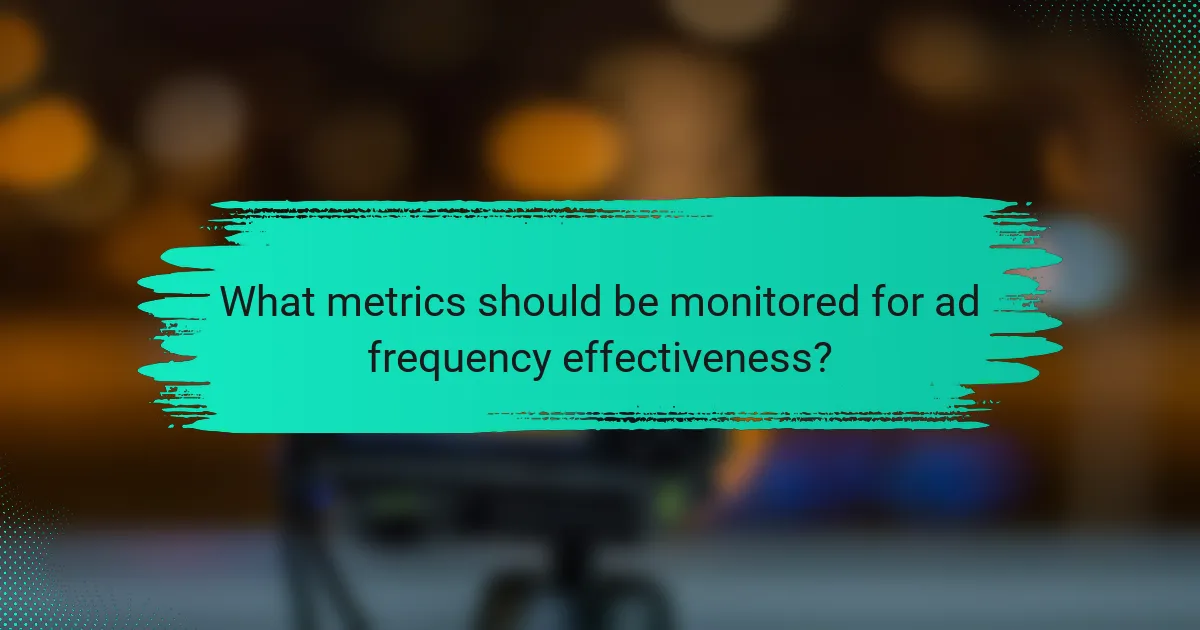
What metrics should be monitored for ad frequency effectiveness?
To assess ad frequency effectiveness, focus on metrics such as click-through rates (CTR) and return on ad spend (ROAS). These indicators provide insights into how often your ads are being viewed and how effectively they convert views into revenue.
Click-through rates (CTR)
Click-through rates (CTR) measure the percentage of users who click on an ad after seeing it. A higher CTR indicates that your ad is engaging and relevant to the audience. Typically, a CTR above 2% is considered good, but this can vary by industry and ad format.
When monitoring CTR, consider the frequency of ad exposure. If users see the same ad too often, CTR may decline due to ad fatigue. Aim for a balance in frequency to maintain engagement while avoiding oversaturation.
Return on ad spend (ROAS)
Return on ad spend (ROAS) calculates the revenue generated for every dollar spent on advertising. A ROAS of 4:1, meaning four dollars earned for every dollar spent, is often seen as a benchmark for effective campaigns. However, acceptable ROAS can vary depending on your business model and industry.
To optimize ROAS, regularly analyze which ads perform best and adjust your budget accordingly. Avoid allocating too much budget to low-performing ads, as this can diminish overall effectiveness. Consider testing different ad creatives and targeting strategies to improve your return.
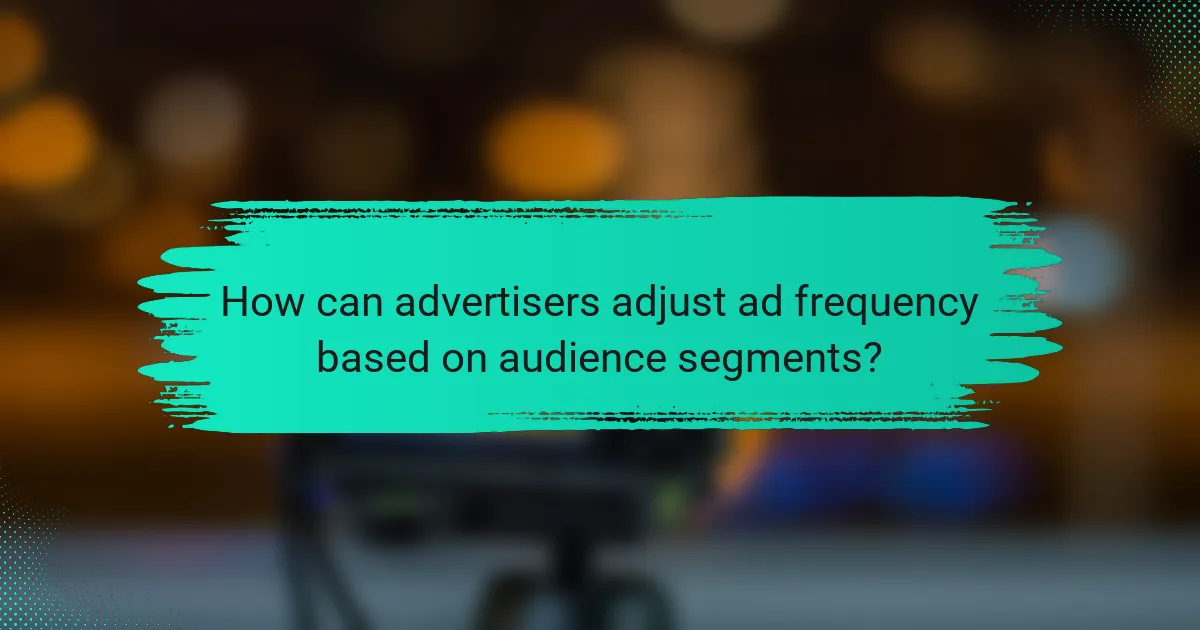
How can advertisers adjust ad frequency based on audience segments?
Advertisers can adjust ad frequency by analyzing audience segments to determine optimal exposure levels. Tailoring frequency based on the value and behavior of different segments can enhance targeting effectiveness and improve engagement rates.
Tailor frequency for high-value segments
High-value segments, such as loyal customers or high-spending prospects, often require a different ad frequency than less engaged users. For these groups, increasing ad exposure can reinforce brand loyalty and drive conversions. A frequency of 3-5 impressions per week may be effective for these segments, ensuring they remain engaged without feeling overwhelmed.
Conversely, lower-value segments may benefit from reduced frequency to avoid ad fatigue. Aiming for 1-2 impressions per week can keep your brand top-of-mind without causing annoyance. Understanding the lifetime value of each segment helps in making these frequency adjustments.
Use A/B testing for frequency optimization
A/B testing is a practical method for optimizing ad frequency across different audience segments. By running experiments with varying frequency levels, advertisers can identify which frequency yields the best engagement and conversion rates. For instance, testing a group with 2 impressions against another with 4 can reveal preferences and effectiveness.
When conducting A/B tests, ensure that sample sizes are large enough to achieve statistically significant results. Monitor key metrics such as click-through rates and conversion rates to gauge performance accurately. Adjustments based on these insights can lead to more effective ad strategies tailored to specific audience needs.

What tools are available for managing ad frequency?
Managing ad frequency is crucial for optimizing targeting effectiveness, engagement rates, and conversions. Various tools are available across platforms like Google Ads and Facebook Ads to help advertisers control how often their ads are shown to users.
Google Ads frequency management tools
Google Ads offers several features to manage ad frequency, including frequency capping and audience targeting options. Frequency capping allows advertisers to limit the number of times an ad is shown to a single user within a specified timeframe, helping to prevent ad fatigue.
Advertisers can set frequency caps based on daily, weekly, or monthly limits. For example, a common approach is to limit impressions to 3-5 times per week per user. Additionally, utilizing audience targeting can help ensure that ads reach the right people without excessive repetition.
Facebook Ads frequency controls
Facebook Ads provides robust frequency control options through its Ads Manager. Advertisers can monitor the frequency metric, which indicates how many times an ad has been shown to the same user, allowing for adjustments as necessary.
To effectively manage frequency, advertisers can use audience segmentation and ad rotation strategies. For instance, rotating different creatives can keep the content fresh while maintaining the same target audience. Aiming for a frequency of around 1.5 to 3 is often recommended to balance visibility and avoid oversaturation.

What are the emerging trends in ad frequency management?
Emerging trends in ad frequency management focus on optimizing how often ads are shown to users to enhance targeting effectiveness and engagement rates. Advertisers are increasingly leveraging technology and data analytics to strike a balance between visibility and user fatigue.
AI-driven frequency optimization
AI-driven frequency optimization utilizes algorithms to analyze user behavior and engagement patterns, allowing advertisers to adjust ad exposure dynamically. This approach helps in determining the optimal number of times an ad should be displayed to maximize conversions without overwhelming the audience.
Key considerations include setting parameters for frequency caps based on user segments and campaign goals. For instance, a brand may choose to show a high-value product ad to a user only a few times within a week, while a promotional offer might warrant more frequent exposure.
To implement AI-driven frequency optimization effectively, advertisers should monitor performance metrics regularly. Common pitfalls include over-relying on automated systems without human oversight, which can lead to misaligned strategies. A balanced approach that combines AI insights with human intuition often yields the best results.
